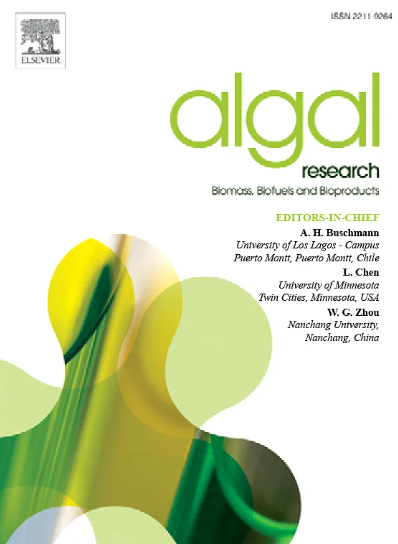环境空气和二氧化碳浓度升高(10%)条件下盐度对斜花菜HTB1形态、生长和色素谱的影响
IF 4.6
2区 生物学
Q1 BIOTECHNOLOGY & APPLIED MICROBIOLOGY
Algal Research-Biomass Biofuels and Bioproducts
Pub Date : 2025-04-08
DOI:10.1016/j.algal.2025.104027
引用次数: 0
摘要
某些微藻物种,如Scenedesmus obliquus菌株HTB1,在高浓度二氧化碳下茁壮成长,这使它们有望通过固碳来减缓气候变化。与巴尔的摩内港隔离,HTB1在10%的二氧化碳中比在环境空气中生长得更快。为了研究其对盐度和高CO2的响应,进行了两个实验。首先,HTB1在环境空气中以7种不同的盐度(0、17.5、20、22.5、25、27.5和30 ppt)(千分之一)培养。较高的盐度导致细胞收缩,颜色由绿色变为淡白色,玉米黄质、叶黄素和叶绿素b等色素减少,但角黄质增加。增长率大幅下降至22.5个百分点以上。第二个实验比较了HTB1在空气和10% CO2条件下对盐度(0,10,20 ppt)的反应。在10% CO2条件下,培养物的颜色变化很小,而在空气条件下,培养物的颜色由绿色变为棕色,盐度对CO2升高条件下的生长抑制作用较小。有趣的是,在二氧化碳浓度为10%的环境中,叶黄素和角黄素的含量随着盐度的升高而升高。这些发现表明,升高的CO2可减轻盐胁迫对HTB1的影响,降低其对生长的影响,促进适应性色素的变化。这项研究揭示了盐度和CO2如何相互作用影响HTB1的形态、生长和色素组成,增强了我们对其弹性和潜在应用的理解。本文章由计算机程序翻译,如有差异,请以英文原文为准。
Impact of salinity on morphology, growth, and pigment profiles of Scenedesmus obliquus HTB1 under ambient air and elevated CO2 (10 %) conditions
Certain microalgal species, such as Scenedesmus obliquus strain HTB1, thrive under high CO2 concentrations, making them promising for carbon sequestration to mitigate climate change. Isolated from the Baltimore Inner Harbor, HTB1 grows faster with 10 % CO2 than with ambient air. To investigate its responses to salinity and elevated CO2, two experiments were conducted. In the first, HTB1 was cultured at seven different salinities (0, 17.5, 20, 22.5, 25, 27.5, and 30 ppt) (parts per thousand) under ambient air. Higher salinity caused cell shrinkage, color changes from green to pale white, reduced pigments like zeaxanthin, lutein, and chlorophyll b, but increased canthaxanthin. Growth declined significantly above 22.5 ppt. The second experiment compared HTB1's response to salinity (0, 10, 20 ppt) under air and 10 % CO2. Cultures under 10 % CO2 showed minimal color changes, while those under air shifted from green to brown, with salinity having less inhibitory effects on growth under elevated CO2. Interestingly, lutein and canthaxanthin levels rose with salinity in 10 % CO2. These findings indicate that elevated CO2 mitigates salt stress in HTB1, reducing its impact on growth and promoting adaptive pigment changes. This study sheds light on how salinity and CO2 interact to influence HTB1's morphology, growth, and pigment composition, enhancing our understanding of its resilience and potential applications.
求助全文
通过发布文献求助,成功后即可免费获取论文全文。
去求助
来源期刊

Algal Research-Biomass Biofuels and Bioproducts
BIOTECHNOLOGY & APPLIED MICROBIOLOGY-
CiteScore
9.40
自引率
7.80%
发文量
332
期刊介绍:
Algal Research is an international phycology journal covering all areas of emerging technologies in algae biology, biomass production, cultivation, harvesting, extraction, bioproducts, biorefinery, engineering, and econometrics. Algae is defined to include cyanobacteria, microalgae, and protists and symbionts of interest in biotechnology. The journal publishes original research and reviews for the following scope: algal biology, including but not exclusive to: phylogeny, biodiversity, molecular traits, metabolic regulation, and genetic engineering, algal cultivation, e.g. phototrophic systems, heterotrophic systems, and mixotrophic systems, algal harvesting and extraction systems, biotechnology to convert algal biomass and components into biofuels and bioproducts, e.g., nutraceuticals, pharmaceuticals, animal feed, plastics, etc. algal products and their economic assessment
 求助内容:
求助内容: 应助结果提醒方式:
应助结果提醒方式:


